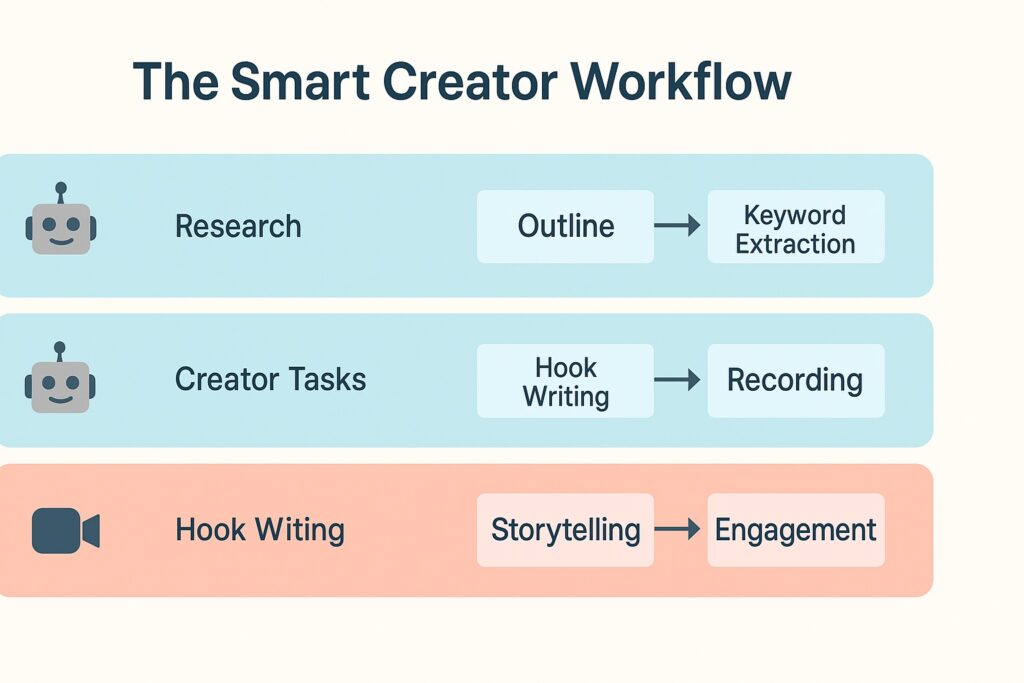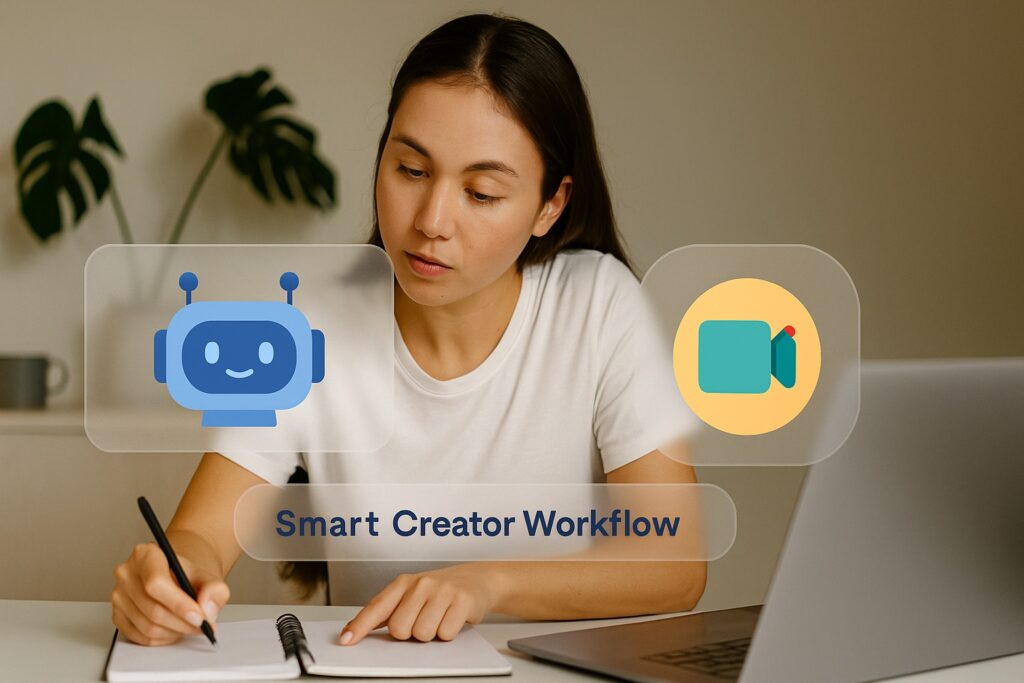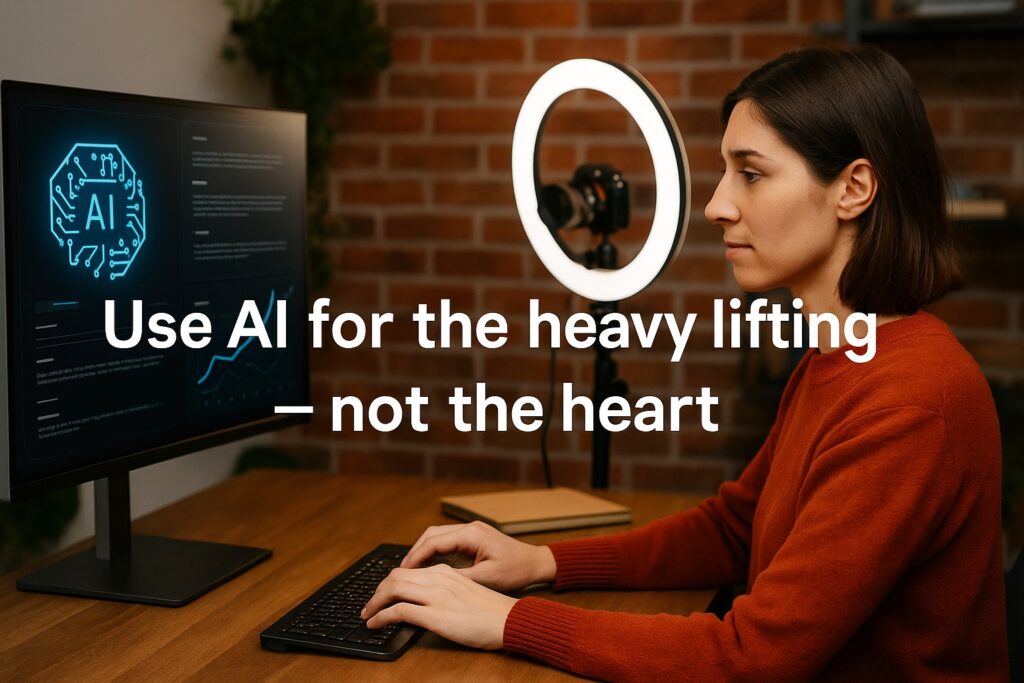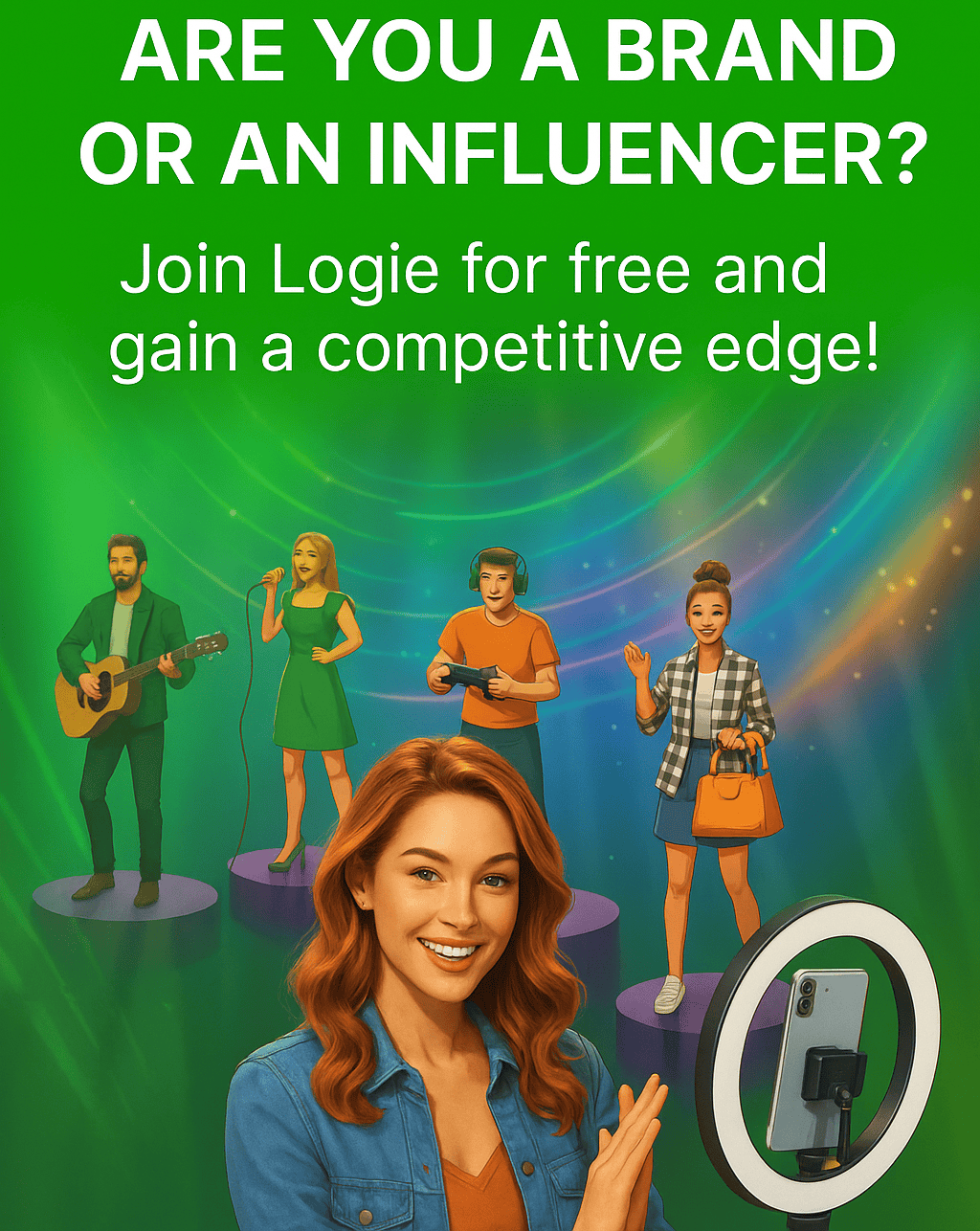In 2025, creators live in two worlds at once.
On one side: Amazon, Logie, and other social commerce platforms are shipping serious automation AI scripts, auto-generated talking points, instant hook ideas, and even “recommended answers” for live shopping and Q&A.
These tools promise speed, consistency, and volume. Amazon’s own ad org openly says the goal is to let brands generate ready-to-run creative “with less effort and better outcomes,” using AI to build images, video, and messaging at scale.
By the way, if you want to stay connected and know everything about social commerce and never miss a beat, join Logie today! Click here
On the other side, there’s a growing anxiety in the creator community. Yes, output is faster. Yes, research is easier. But at what point does efficiency become sameness? At what point does your channel stop sounding like you?
That tension came through clearly in a recent Logie community session, where seasoned Amazon influencer and strategist Ehud Segev said:
“THE PROBLEM IS THAT MANY TIMES, THE AI IS TALKING, INSTEAD OF US… SO MANY OF US JUST STOPPED CREATING WHAT WE REALLY FEEL, AND WE JUST LET THE AI TALK… YOU THINK YOU CREATE, BUT ALL YOU DO IS EMULATE.”
That line hit hard because it’s the fear under the surface for a lot of creators right now. The fear is not “AI is coming for my job.” The fear is “my audience won’t recognize me anymore.”
Let’s talk about how to keep that from happening.
Is AI a Threat or a Creative Partner?
For most working creators, AI is already part of the workflow, whether they admit it publicly or not.
It’s brainstorming product angles. It’s helping outline a comparison video when you’ve only got 20 minutes before school pickup. It’s generating bullet points you can read in your livestream when chat is moving too fast.
About 69%+ of marketers report they’re already using AI in day-to-day content operations, and more than 70% believe AI can outperform humans in specific marketing tasks.
At the same time, almost 60% of those same marketers are openly worried AI could replace them.
Creators are feeling that same split emotion.

Here’s the nuance most outsiders miss: creators aren’t scared of AI helping. They’re afraid of AI flattening. When everything is “optimized,” nothing feels alive. And when nothing feels alive, trust falls.
Industry data backs that up. Creators and brand leaders keep circling the same word: authenticity.
In 2025, authenticity and relatability are still the things that drive absolute trust, sales, and repeat attention, especially for micro and mid-tier creators, who win specifically because they feel real, specific, and human.
So, no AI isn’t automatically “bad.” But using AI without intention can erase the exact thing audiences come for.
The Workflow Revolution
The truth is, workflow automation is exploding.
- Logie-style creator platforms can now draft scripts, pull high-performing hooks, and prep product talking points for you.
- Amazon and Amazon Ads are rolling out AI systems that help brands spin up creative assets fast, images, demo-style clips, refined copy, and push them into shoppable surfaces.
- Live shopping tools (Amazon Live, TikTok Shop, etc.) have started to move beyond “go live and wing it.” They increasingly offer on-screen prompts, FAQ assist, and pre-generated selling language so creators can move product more efficiently.
On paper? Amazing. This is what lets a one-person creator business operate like a whole media team.
But here’s the pitfall: if you lean on these assistants too literally, your videos start sounding like everyone else’s videos. You stop narrating from lived experience and start narrating like a brochure. And the audience can tell.
That’s precisely what Ehud was warning about: when “the AI is talking instead of us,” you’re not just automating tasks, you’re outsourcing your point of view.
We’re already seeing early warning signs in the marketplace: creators are reporting that when they read AI-perfect scripts word-for-word, comments drop, watch time slips, and people stop DM-ing follow-up questions. Meanwhile, pieces where they rant, laugh, share something slightly chaotic, or admit “this part annoyed me” still outperform because that feels like a person, not a spec sheet.
And audiences care. A May 2025 report shows 61% of consumers believe influencers should disclose when they use AI, and 35% say they distrust AI-generated influencer content.

At the same time, 81% of creators say AI has helped their engagement, which tells you the balance point is “AI assist + human honesty,” not “AI instead of human.”
So the risk isn’t “using AI.” The risk is “sounding synthetic.”
Where AI Is Non-Negotiably Useful
There are places where not using AI at all slows you down for no reason. Smart creators are unapologetically automating:
1. Research + Prep
Scanning specs, reading through 200 reviews, and figuring out what actually matters to buyers? AI can summarize that in minutes.
Amazon itself is leaning into AI-generated “highlights” at the top of product pages, fast summaries of what shoppers keep mentioning in reviews, common pain points, and standout benefits.
Those highlights are designed to help the shopper decide faster. That same style of summary can help you prep talking points faster.
But, and this is critical, you should not just repeat that language on camera. Use it to inform what you want to say.
2. Draft Structure
Most creators don’t struggle with “what do I think?” They struggle with “how do I say this cleanly in under 60 seconds?” AI is fantastic at spitting out a 3-beat structure:
- Hook/pain
- What it does
- Who it’s really for
That scaffolding saves you time, especially when you’re batching content for Prime Day, Father’s Day, back-to-school, Q4, etc.
3. Repetitive Legal / CTA / Housekeeping
Stas Ive described using AI as a “thought partner,” not a ghostwriter. His playbook:
- Let AI generate standard disclaimers, intros, FTC-friendly clarifications, and closing CTAs.
- Let AI surface trending topics or noticeable gaps in your niche.
- Let AI crunch analytics after the fact so you spend your creative brain on the next thing, not spreadsheets.

That’s the right mental model: AI handles the boring plumbing so you can spend more time on the part only you can do.
Where AI Should Never Replace You
There are parts of your content that have to stay human if you want to build durable value and not get replaced by a cheaper synthetic version five minutes from now. This is where you defend your “voice moat.”
1. Opinions, Frustrations, and “Real-World Use”
AI can list features. AI can’t tell me, “Here’s where it annoyed me.”
It can’t say, “This hinge sounds cheap after a week,” or “The battery really does die faster in the cold.”
That level of lived detail is what shoppers trust, and 78%+ of consumers say they trust brands more when they’re recommended by real, relatable creators, not polished brand voices.
This is literally your survival edge.
2. Your Environment
AI can generate a perfect studio kitchen. It cannot recreate your tiny apartment kitchen with the scratched counter and the air fryer that never leaves the stove.
That context is what makes buyers think, “Oh, that looks like my life.” AI influencers are getting more photoreal and cheaper for brands, but they’re still seen as less emotionally authentic and can even hurt brand trust if audiences feel misled.
Your mess is part of your moat.
3. Your Micro-Stories
“This is what happened when my kid tried to grab it.”
“I actually returned the first one.”
“I bought this with my own money long before the brand reached out.”
That is the stuff AI cannot convincingly fake at scale, and it’s also the stuff that keeps you from blending into 400 other “TikTok Made Me Buy It” clones.

Ehud’s warning, “you think you create, but all you do is emulate,” is precisely about losing these moments. When your story disappears, so does your moat.
Four Practical Habits to Stay Human
Here’s what top-performing Amazon/UGC creators are doing right now to balance speed with soul:
1. Use AI for the “heavy lifting,” not the heart
Let AI gather talking points, but you record the hook and the close in your own unscripted voice first. Then, if you want, layer in any missing facts. Your opener and your punchline should still sound like you.
2. Treat AI output like a draft, not a teleprompter
Mark it up. Add sarcasm. Add “I didn’t like this part.” Cut any phrasing you would never say in a real conversation. If the paragraph sounds like a brochure, rewrite it in your texting voice.
A trick many Logie creators use:
- Record a messy first take without looking at the AI script.
- Then glance at the AI draft and see if there’s anything helpful you forgot.
- Combine. Don’t swap.
3. A/B test yourself vs. your assistant
Do one review in pure you. Do another where you leaned heavily on an AI structure. Post both different products, same style/format. Watch:
- Average watch time
- Comment quality (Are people asking follow-ups, or just “link?”)
- Save/share rate
Over and over, creators are finding that the winning formula is “AI for prep + human delivery,” not “AI replaces delivery.”
That aligns with broader market data: AI can drive reach and volume, but audiences still anchor on perceived authenticity, and authenticity is what brands are literally prioritizing when choosing creators in 2025.
4. Be open about it
This one sounds scary, but it’s about trust. A 2025 survey shows 61% of consumers actually want influencers to disclose when AI helped shape content.
That means saying something like, “I used AI to organize the specs, but this is my honest take after two weeks of using it.”
Far from hurting you, that kind of transparency builds authority. You’re telling your audience: I do my homework, but I’m still the one talking to you.
The Mindset Shift
AI can absolutely feel like competition, especially as Amazon experiments with AI-generated page highlights, on-page Q&A assistants, and eventually auto-generated video demos that might live in the same real estate you’re trying to dominate.
But the creators who are winning right now are reframing it the way Stas Ive described: AI is a “thought partner.”
That means:
- AI surfaces opportunities (What products are trending? Where’s the content gap on a listing?)
- AI drafts the boring stuff (disclaimers, CTAs, “here are the specs”)
- You focus on what cannot be mass-produced: point of view, proof, presence, personality.
Said differently: AI should clear the runway. You are still the pilot.
Final Takeaways
- Don’t fear AI. Fear sounding like AI.
- Keep your weird. Your irritation. Your hacks. Your lived context. That is your moat.
- Use AI to buy back time, not to erase your fingerprint.
- Be transparent about how you work. Audiences actually like it and brands increasingly reward it.
- Treat every script, outline, or workflow prompt as “support,” never as “voice.”
Here’s the blunt truth: platforms will keep automating. Amazon is already leaning into AI that helps shoppers skip straight to “the important stuff,” sometimes before they ever hit a creator video.
Brands are already testing AI-generated influencers because they’re scalable, on message, and drama-free.
That means the creators who thrive from here aren’t just “good on camera.” They’re good at being unmistakably themselves.
Your job from now on is to get faster, yes, but never get replaceable.










